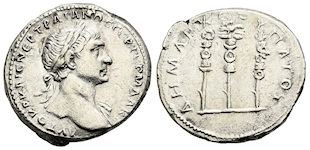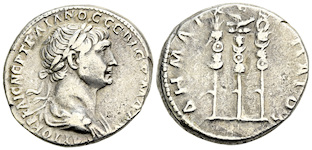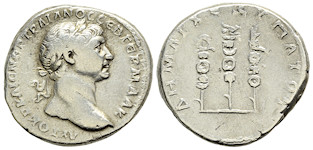Fine Coins Showcase
Antiquities Showcase
Show Empty Categories
Shop Search
Shopping Cart
My FORVM
Contact Us
About Forum
Shopping at Forum
Our Guarantee
Payment Options
Shipping Options & Fees
Privacy & Security
Forum Staff
Selling Your Coins
Identifying Your Coin
FAQs
zoom.asp
Home ▸ Catalog ▸ |Roman Coins| ▸ |The Adoptive Emperors||View Options:   | | | | | | |


In Roman mythology, Aequitas was the minor goddess of fair trade and honest merchants. Aequitas was also the personification of the virtues equity and fairness of the emperor (Aequitas Augusti). The scales, a natural emblem of equity, express righteousness. The cornucopia signifies the prosperity which results from Aequitas and Aequitas Augusti.SL113464. Silver denarius, RIC II 13, RSC II 6, BnF III 13, BMCRE III 24, Hunter I 9, SRCV II -, NGC Ch AU, strike 4/5, surface 5/5 (2400906-010), weight 3.32 g, maximum diameter 18.5 mm, die axis 180o, Rome mint, 97 A.D.; obverse IMP NERVA CAES AVG P M TR P COS III P P, laureate head right; reverse AEQVITAS AVGVST (fairness of the emperor), Aequitas standing half left, head left, wearing stephane, scales in right hand, cornucopia in left hand; from a Virginia Collector, ex Eastern Numismatics Inc. (Garden City, NY, 20 Dec 2010, $2140); NGC| Lookup;
Antoninus Pius, August 138 - 7 March 161 A.D.


Liberalitas coin types attest to occasions when the emperor has displayed his generosity towards the people by a distribution to them of money, provisions, or both. The first mention of Liberalitas was on coins of Hadrian. It was a type frequently repeated by the succeeding emperors. Indeed these instances of imperial generosity are more carefully recorded on coins than they are by history. Liberality is personified by the image of a woman, holding in one hand a counting board, or square tablet with a handle on which are cut a certain number of holes. These boards were used to quickly count the proper number of coins or other items for distribution to each person. In the other hand she holds a cornucopia, to indicate the prosperity of the state and the abundance of wheat contained in the public granaries.SL113467. Silver denarius, RIC III 237 (R); RSC II 518; BMCRE IV p. 119, 821; Strack III 273; Hunter II -; SRCV II -, NGC Ch MS, strike 5/5, surface 5/5 (2400906-011), weight 3.35 g, maximum diameter 18 mm, die axis 180o, Rome mint, 153 - 154 A.D.; obverse ANTONINVS AVG PIVS P P TR P XVII, laureate bust right; reverse LIBERALITAS VII COS IIII, Antoninus standing slightly left, bare head (with recognizable portrait!) left, togate, coin counting board in right hand, roll in left hand; from a Virginia Collector, ex Eastern Numismatics Inc. (Garden City, NY, 20 Dec 2010, $1650); NGC| Lookup; rare;
Lucius Verus, 7 March 161 - February 169 A.D.


In 162, Lucius Verus began war with the Parthians after Vologases IV invaded Syria and Armenia. The Romans would be victorious but the returning army would bring back a pandemic known as the Antonine Plague. The plague would significantly depopulate the entire Roman Empire.SL113468. Silver denarius, RIC III p. 253, 482; RSC II 155; BMCRE IV p. 412, 202; Hunter II p. 368, 7; cf. SRCV II 5354 (TR P III), NGC Ch AU, strike 5/5, surface 4/5 (3989805-005), weight 2.88 g, maximum diameter 17 mm, die axis 180o, Rome mint, Dec 161 - Dec 162 A.D.; obverse IMP L AVREL VERVS AVG, bare head right; reverse PROV DEOR TR P II COS II, Providentia standing facing, head left, globe in right hand, cornucopia in left hand; from a Virginia Collector, ex Eastern Numismatics Inc. (Garden City, NY, 21 Mar 2016, $995); NGC| Lookup;
Trajan, 25 January 98 - 8 or 9 August 117 A.D., Arabian Tridrachm Series, "Rome" Style


In a 1997 book review in the Schweizerische Numismatische Rundschau (SNR), Kevin Butcher agreed with William Metcalf that the Greek inscribed silver "coinage of Trajan dated to his sixth consulship" is part of the "Rome style" club. He goes on to write, "The existence of this Rome style coinage in the eastern provinces caused great confusion in the past, with a whole series of coins which we now know belong to Syria, Arabia and Cyrenaica being given to Caesarea by Sydenham. It is largely thanks to M.'s [Metcalf's] work on Caesarea and the Arabian coinage that most of the issues have been reattributed away from Caesarea. The source of confusion was the stylistic similarity of all of these groups, because they are all in the style of the Rome mint." Just how involved Rome was in the minting of these coin groups is still a mystery. Its complexity is suggested by a probable Rome style Arabian drachm of Trajan (RPC III 4075) overstruck on a Nabatean drachm. See FORVM RS113121 for this example!
The obverse legend sports what appears on first glance to be a glaring error: CEP in place of CEB, but the comparison of another coin from the same die pair assures us that the die cutter did not allow such a blunder to mar his masterful work. This includes rejecting the scenario where the die cutter simply modified the letter at some point afterwards, since our coin is in a later die state than the other.RY114284. Silver tridrachm, RPC Online III 4055 (15 spec.); Woytek Cistophore A1b.1; Ganschow X14b; SNG Fitz 5436; SNG ANS 1163; Tell Kalak pl. XIII, 9; Sydenham Caesarea 225, gVF, light toning, bold strike with traces of die wear, very fine style, befitting the mint of Rome, weight 10.156 g, maximum diameter 24.5 mm, die axis 180o, struck for use in Arabia by Rome or Arabian mint, "Tr Pot Cos VI" issue, 112 - 114 A.D.; obverse AYTOKP KAIC NEP TPAIANOC CEB ΓEPM ΔAK (Imperator Caesar Nerva Traianus Augustus Germanicus Dacicus), laureate bust right, slight drapery on far (left) shoulder; reverse ΔHMAPX EΞ YΠATO ϛ (tribunicia potestate, consul VI - holder of Tribunician power, consul six times), aquila between two signa (standards), wreath on top of left signum, hand on top of right signum;
Trajan, 25 January 98 - 8 or 9 August 117 A.D., Arabian Tridrachm Series, "Rome" Style


In a 1997 book review in the Schweizerische Numismatische Rundschau (SNR), Kevin Butcher agreed with William Metcalf that the Greek inscribed silver "coinage of Trajan dated to his sixth consulship" is part of the "Rome style" club. He goes on to write, "The existence of this Rome style coinage in the eastern provinces caused great confusion in the past, with a whole series of coins which we now know belong to Syria, Arabia and Cyrenaica being given to Caesarea by Sydenham. It is largely thanks to M.'s [Metcalf's] work on Caesarea and the Arabian coinage that most of the issues have been reattributed away from Caesarea. The source of confusion was the stylistic similarity of all of these groups, because they are all in the style of the Rome mint." Just how involved Rome was in the minting of these coin groups is still a mystery. Its complexity is suggested by a probable Rome style Arabian drachm of Trajan (RPC III 4075) overstruck on a Nabatean drachm. See FORVM RS113121 for this example!
RY114285. Silver tridrachm, RPC Online III 4060, Metcalf Tell Kalak 13, SNGvA 6399, Woytek Cistophore A1v.2, Ganschow X14e, Sydenham Caesarea -, VF, toned surfaces, worn rev. die, obv. of fine style, superb portrait, weight 9.842 g, maximum diameter 23.2 mm, die axis 225o, struck for use in Arabia by Rome or Arabian mint, "Tr Pot Cos VI" issue, 112 - 114 A.D.; obverse AYTOKP KAIC NEP TPAIANOC CEB ΓEPM ΔAK, laureate and draped bust right, seen from front; reverse ΔHMAPX EΞ YΠATO ϛ (holder of Tribunician power, consul six times), two standards (signa) flanking an aquila with hand atop left standard and wreath atop right standard; very rare;
Hadrian, 11 August 117 - 10 July 138 A.D., Ascalon, Philistia, Judaea, Extremely Rare Duel Dated Variant


RPC Online III notes of their specimen, "The date does seem to begin with E, even though one would expect ς with year 4 of the second era. Confirmation required. If correctly read, it might show that the Hadrianic era began at a different time of year from the normal city era, or it might just be a mistake, as commonly happened at Gaza." Our coin appears to have the expected date, but with a reversed ς.RP111379. Bronze AE 24, Unpublished variant, RPC Online III 4014A var. (EKC, the only known specimen), VF, attractive highlighting earthen deposits, rev. off center, weight 12.265 g, maximum diameter 23.5 mm, die axis 0o, Askalon (Ashqelon, Israel) mint, 132 - 133 A.D.; obverse CEBAC-TOC (starting counterclockwise on right, ending counterclockwise on left), laureate, draped and cuirassed bust right, seen from behind; reverse ACKΛAW upward on left, Tyche-Astarte standing half left on prow, head left, vexillum standard in right hand, aphlaston in left hand, LΔ (year 4 [of Hadrian]) over incense altar inner left; dove standing left over ΣKC ([year] 226 [of Ascalon], Σ reversed) lower right; extremely rare;
Trajan, 25 January 98 - 8 or 9 August 117 A.D., Antioch, Seleucis and Pieria, Syria


Herakles is depicted wearing the Nemean lion skin around his neck. The first of Herakles' twelve labors, set by his cousin King Eurystheus, was to slay the Nemean lion and bring back its skin. Herakles discovered arrows and his club were useless against it because its golden fur was impervious to mortal weapons. Its claws were sharper than swords and could cut through any armor. Herakles stunned the beast with his club and, using his immense strength, strangled it to death. During the fight, the lion bit off one of his fingers. After slaying the lion, he tried to skin it with a knife but failed. Wise Athena, noticing the hero's plight, told him to use one of the lion's own claws to skin the pelt.RP114280. Silver tetradrachm, RPC Online III 3536, McAlee 459 (rare), Wruck 156, Prieur 1514, VF, centered, double struck, areas of mild porosity, edge cracks, weight 14.051 g, maximum diameter 25.8 mm, die axis 180o, Antioch (Antakya, Turkey) mint, 109 - 110 A.D.; obverse AVTOKP KAIC NEP TPAIANOC CEB ΓEPM ΔAK (Imperator Caesar Nerva Trajanus Augustus Germanicus Dacicus), laureate head right, club left below, eagle at point of bust standing right with wings closed; reverse ΔHMAPX - EΞ IΔ YΠAT E (tribunicia potestate XIV, consul VI), laureate bust of Melqart-Herakles right, Nemean lion-skin around neck, tied at front; first specimen of this type handled by FORVM; rare;
Trajan, 25 January 98 - 8 or 9 August 117 A.D., Arabian Tridrachm Series, "Rome" Style


In a 1997 book review in the Schweizerische Numismatische Rundschau (SNR), Kevin Butcher agreed with William Metcalf that the Greek inscribed silver "coinage of Trajan dated to his sixth consulship" is part of the "Rome style" club. He goes on to write, "The existence of this Rome style coinage in the eastern provinces caused great confusion in the past, with a whole series of coins which we now know belong to Syria, Arabia and Cyrenaica being given to Caesarea by Sydenham. It is largely thanks to M.'s [Metcalf's] work on Caesarea and the Arabian coinage that most of the issues have been reattributed away from Caesarea. The source of confusion was the stylistic similarity of all of these groups, because they are all in the style of the Rome mint." Just how involved Rome was in the minting of these coin groups is still a mystery. Its complexity is suggested by a probable Rome style Arabian drachm of Trajan (RPC III 4075) overstruck on a Nabatean drachm. See FORVM RS113121 for an example!RY114286. Silver tridrachm, RPC Online III 4062A (5 spec.), Woytek Cistophore A1h.1, Ganschow X14d, cf. Metcalf Tell Kalak 8-10 (diff. busts), Sydenham Caesarea 224-226 (same), gVF, great centering, fine style obv. showcasing a high point in Roman imperial portraiture, patch of roughness on neck, otherwise smooth surfaces, mild die wear, weight 10.575 g, maximum diameter 25.1 mm, die axis 180o, struck for use in Arabia by Rome or Arabian mint, "Tr Pot Cos VI" issue, 112 - 114 A.D.; obverse AYTOKP KAIC NEP TPAIANOC CEB ΓEPM ΔAK, laureate, draped, and cuirassed bust right, seen from front; reverse ΔHMAPX EΞ YΠATO ϛ (holder of Tribunician power, consul six times), two standards (signa) flanking an aquila with wreath atop left standard and hand atop right standard; Published in RPC Online III (#4 = this coin!); very rare;
Trajan, 25 January 98 - 8 or 9 August 117 A.D., Arabian Tridrachm Series, "Rome" Style


In a 1997 book review in the Schweizerische Numismatische Rundschau (SNR), Kevin Butcher agreed with William Metcalf that the Greek inscribed silver "coinage of Trajan dated to his sixth consulship" is part of the "Rome style" club. He goes on to write, "The existence of this Rome style coinage in the eastern provinces caused great confusion in the past, with a whole series of coins which we now know belong to Syria, Arabia and Cyrenaica being given to Caesarea by Sydenham. It is largely thanks to M.'s [Metcalf's] work on Caesarea and the Arabian coinage that most of the issues have been reattributed away from Caesarea. The source of confusion was the stylistic similarity of all of these groups, because they are all in the style of the Rome mint." Just how involved Rome was in the minting of these coin groups is still a mystery. Its complexity is suggested by a probable Rome style Arabian drachm of Trajan (RPC III 4075) overstruck on a Nabatean drachm. See FORVM RS113121 for this example!RY114288. Silver tridrachm, RPC Online III 4053 (25 spec.); Woytek Cistophore A1a.1; Tell Kalak pl. XIII, 8; SNG ANS 1162; BMC Galatia p. 57, 88; Ganschow X14a, aVF, fine style portrait, very lightly toned minor hairline scratches, traces of die wear, weight 10.166 g, maximum diameter 23.8 mm, die axis 210o, struck for use in Arabia by Rome or Arabian mint, "Tr Pot Cos VI" issue, 112 - 114 A.D.; obverse AYTOKP KAIC NEP TPAIANOC CEB ΓEPM ΔAK (Imperator Caesar Nerva Traianus Augustus Germanicus Dacicus), laureate head (or bust) right; reverse ΔHMAPX EΞ YΠATO ϛ (tribunicia potestate, consul VI - holder of Tribunician power, consul six times), aquila between two signa (standards), wreath on top of left signum, hand on top of right signum;
Trajan, 25 January 98 - 8 or 9 August 117 A.D., Antioch, Seleucis and Pieria, Syria


Herakles is depicted wearing the Nemean lion skin around his neck. The first of Herakles' twelve labors, set by his cousin King Eurystheus, was to slay the Nemean lion and bring back its skin. Herakles discovered arrows and his club were useless against it because its golden fur was impervious to mortal weapons. Its claws were sharper than swords and could cut through any armor. Herakles stunned the beast with his club and, using his immense strength, strangled it to death. During the fight, the lion bit off one of his fingers. After slaying the lion, he tried to skin it with a knife but failed. Wise Athena, noticing the hero's plight, told him to use one of the lion's own claws to skin the pelt.RP114277. Silver tetradrachm, RPC III 3533, Prieur 1496, McAlee 458, Wruck 151, VF, broad flan, double struck, edge cracks, graffito X obverse right field, weight 14.097 g, maximum diameter 27.2 mm, die axis 180o, Antioch (Antakya, Turkey) mint, 103 - 111 A.D.; obverse AVTOKP KAIC NEP TPAIANOC CEB ΓEPM ΔAK (Imperator Caesar Nerva Trajanus Augustus Germanicus Dacicus), laureate head right, club left below, eagle standing right with wings closed at point of bust; reverse ΔHMAPX - EΞ IE YΠAT E (tribunicia potestate, consul V), laureate bust of Melqart-Herakles right, Nemean lion-skin around neck tied at front, cruder larger bust style variant;
Page created in 1.031 seconds.









